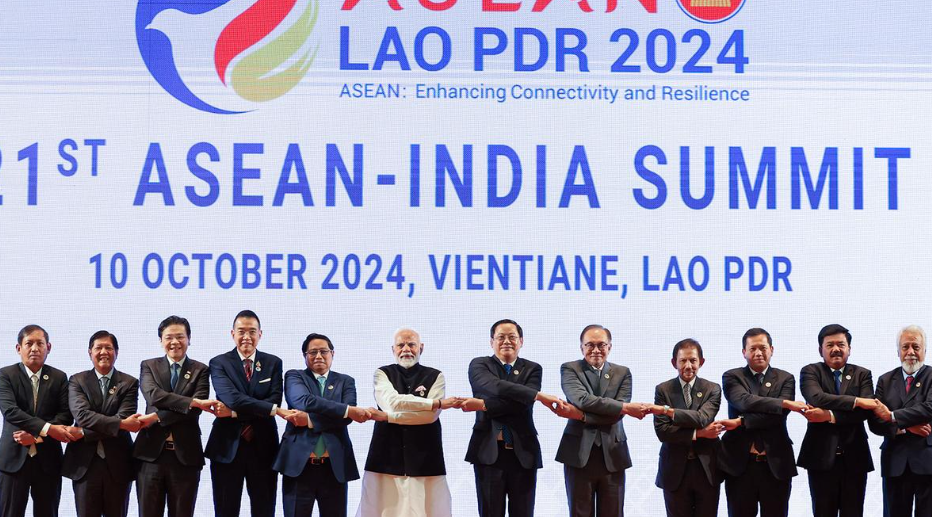A Collective Effort Towards Peace in Myanmar (GS Paper 2, IR)

Context
- The need for a collective and pragmatic approach towards Myanmar's ongoing crisis has become urgent. Both ASEAN (Association of Southeast Asian Nations) and India must engage all key stakeholders to foster stability in the region.
Introduction
- The 44th ASEAN Summit, held from October 6 to 11 in Vientiane, Laos, underscored the escalating concerns over Myanmar's deteriorating situation.
- Since the military coup in 2021, the country has been embroiled in a severe civil war, and efforts like ASEAN's Five-Point Consensus have yielded limited results.
- This ongoing turmoil not only affects Myanmar but also poses a challenge to ASEAN's credibility as a bloc committed to peace and stability.
The Situation in Myanmar
Current Crisis
- Myanmar is currently engulfed in a brutal civil war, primarily between the military junta and various resistance groups, including Ethnic Armed Organizations (EAOs) and the People's Defence Forces (PDFs).
- After the military coup that ousted the democratically elected government of Aung San Suu Kyi, widespread armed resistance has emerged.
- Resistance groups now control substantial territories, including six major border trade routes.
- The junta’s attempts to suppress the rebellion have resulted in severe violence, displacing hundreds of thousands of people and creating a significant humanitarian crisis.
- According to the United Nations, over 18.6 million people, including 6 million children, urgently require assistance.
International Response
- The junta's failure to cooperate with international peace initiatives has intensified the conflict.
- It continues to label opposition groups as terrorists and shows little interest in genuine negotiations.
- In 2021, ASEAN broke its longstanding non-interference policy to address the coup, acknowledging a breach of the ASEAN Charter regarding rule of law and governance.
- However, efforts to implement the Five-Point Consensus—calling for an end to violence, inclusive dialogue, and humanitarian assistance—have largely been ignored, highlighting the limitations of regional responses.
ASEAN's Engagement
- Initially, ASEAN attempted to exclude Myanmar's military leaders from high-level meetings due to non-compliance with the Five-Point Consensus.
- However, during the recent summit, Myanmar participated by sending Aung Kyaw Moe, a senior Foreign Ministry official.
- This marks a pragmatic shift in ASEAN's approach, indicating the junta's willingness to engage in dialogue, albeit under challenging circumstances.
Divergent Approaches Among ASEAN Members
- Different ASEAN members have adopted varied stances on the crisis.
- Countries like Indonesia, Malaysia, and the Philippines advocate for stronger action against the junta, while Thailand, Cambodia, and Laos maintain closer ties with the military government.
- The principle of consensus-based decision-making complicates regional responses, often leading to diluted outcomes.
- Thailand’s recent proposal to host informal talks with a Troika involving Indonesia, Laos, and Malaysia exemplifies an effort to overcome diplomatic deadlock.
- However, without the involvement of all stakeholders, including the National Unity Government and EAOs, these initiatives may fall short.
India’s Myanmar Policy
Engagement with Myanmar
- During the 21st ASEAN-India Summit and the 19th East Asia Summit, Prime Minister Narendra Modi emphasized ASEAN's central role and the importance of the Five-Point Consensus while encouraging sustained engagement with Myanmar.
- India's policy is closely tied to its Act East Policy, viewing Myanmar as a critical land bridge to ASEAN countries.
- With a 1,643 km-long border with Myanmar, India seeks to balance security concerns regarding cross-border militancy and illegal activities while maintaining relations with Myanmar’s military regime and supporting democratic processes through diplomatic channels.
Connectivity Projects
- India is involved in various connectivity initiatives, such as the Kaladan Multi-Modal Transit Transport Project and the India-Myanmar-Thailand Trilateral Highway.
- These projects aim to enhance trade and connectivity, with recent agreements focused on agricultural development, vocational training, disaster management, and education.
- However, political instability in Myanmar poses challenges to the successful implementation of these initiatives.
Security Concerns and Policy Adjustments
- Concerns over regional stability and the potential influx of refugees have led India to discontinue the Free Movement Regime along the border and to construct fencing.
- This has faced resistance from various state governments, complicating India's approach to its neighbor.
Conclusion
- As the situation in Myanmar remains precarious, New Delhi is considering broader engagement with various stakeholders to safeguard its strategic interests and contribute to regional peace and stability.
- The effectiveness of this strategy will hinge on the evolving dynamics within Myanmar and India’s ability to engage meaningfully with all parties involved.
- A more inclusive and pragmatic approach by both ASEAN and India is essential to foster dialogue and stability in Myanmar, emphasizing the importance of involving all key stakeholders in the peace process.


